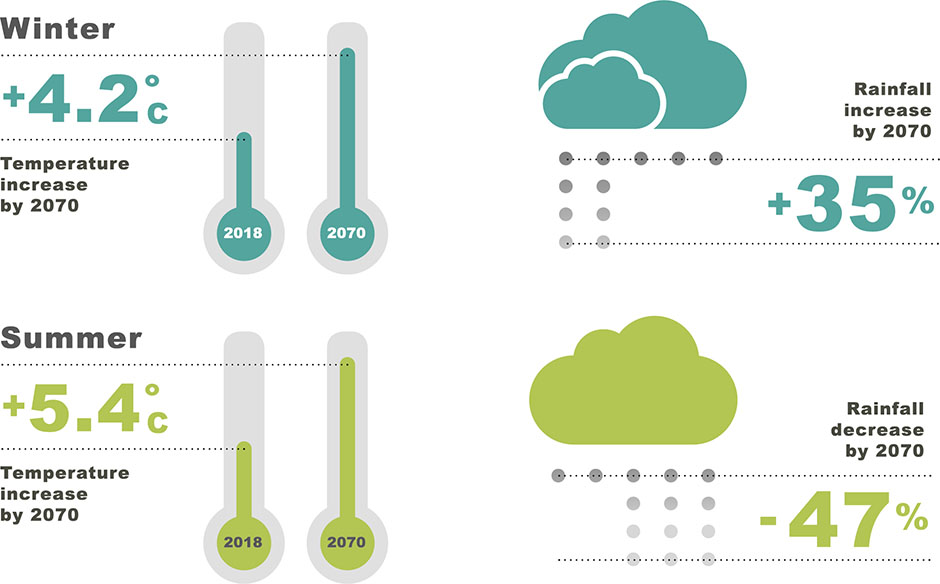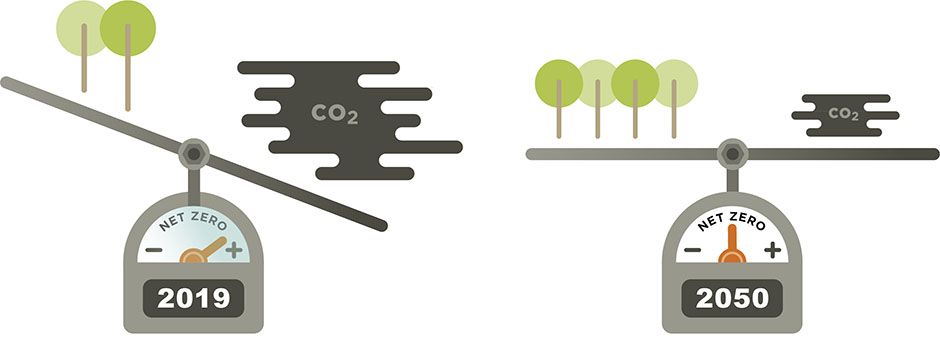Greater Cambridge Local Plan Issues & Options 2020
4.1 Climate change
Figure 12 Climate change in Greater Cambridge
Climate change is a defining issue of today and will have serious impacts for future generations. In response to the climate crisis, the two Councils and the County Council have committed[24] to achieve net zero carbon by 2050.
Net zero carbon means, on balance, not creating more CO2 than is stored up or offset. Any carbon emissions we create through burning fossil fuels must be balanced out by schemes to absorb it back out of the atmosphere – such as planting trees or using technology such as carbon capture and storage. In reality we can only absorb and offset a small amount of CO2. This means the vast majority of our energy needs must be met by renewable forms of energy, and this will only be possible by reducing our energy use drastically.
The Local Plan will play a key part in helping us achieve this challenge, but this will affect how we address other priorities that are important to the area. It will influence where we plan for development, and how it is designed – and this may not be welcomed by everyone, as we will have to plan for low-carbon lifestyles and encourage low carbon activities and alternatives to private car use. We want to hear from you about how we should best meet the climate challenge and balance this with other issues for the Local Plan.
Question
(189) 8. How should the Local Plan help us achieve net zero carbon by 2050?
4.1.1 What do we have to do?
Figure 13 Understanding net zero carbon
National planning policy requires local planning policies to be "in line with the objectives and provisions of the Climate Change Act 2008". In August 2019, the Climate Change Act was amended to set a target for carbon emissions in the UK to become net zero carbon by 2050.
4.1.2 What are we already doing?
Our adopted 2018 Local Plans include policies which respond to climate change. We require large scale developments to be exemplars in sustainability standards, for example, by increasing the amount of renewable energy generation on site, or using new construction methods to minimise construction waste and maximise energy efficiency through offsite construction and modular build techniques.
Once adopted in 2020, our new Sustainable Design and Construction Supplementary Planning Document[25] will support these adopted planning policies. However, there needs to be a big step up in order to meet the net zero target by 2050 and we need to start addressing it now.
Cambridgeshire County Council have commissioned new research that will inform the next Local Plan, which will include understanding the level of carbon emissions within the Greater Cambridge area today, known as carbon footprinting[26]. This has been carried out in collaboration with the University of Cambridge's Science Policy Exchange and Department of Land Economy, and the outputs of Carbon Neutral Cambridge's Zero Carbon Symposium, held in Cambridge in May 2019[27] will also help inform future policy. We are also commissioning further work to test options for higher standards of carbon reduction, which will help us understand potential to achieve net zero carbon new development.
4.1.3 What are the key issues?
We want to know how you think we should use the next Local Plan to meet the key challenges of significantly reducing our climate impacts, whilst having enough flexibility so that we can respond effectively to the changing climate in the future.
Figure 14Climate change mitigation and adaptation strategies
Mitigating climate change
Climate change mitigation means reducing our impact on the climate as far as possible. This involves:
- Designing new communities, infrastructure and buildings to be energy and resource efficient, both in the way they are built and the way they are used over their lifespan.
- Using renewable and low carbon energy generation.
- Promoting patterns of development that enable travel by low-carbon modes such as walking, cycling and public transport.
- Discouraging our communities from using private cars where possible, and other lifestyle choices that affect the climate.
- Retrofitting existing buildings to be more energy efficient.
- Considering the role of the plan regarding materials used in the construction process.
- Investigating how carbon offsetting can be supported through tree planting and other measures.
- Supporting local and community opportunities for growing food.
Question
(157) 9. How do you think we should be reducing our impact on the climate? Have we missed any key actions?
Adapting to climate change
Climate change adaptation means ensuring that our communities can evolve as our climate changes – to more extreme weather, a hotter climate, and a changing ecology. This includes:
- Ensuring that we are safe from flood risk and extreme weather events.
- Designing buildings and places so that they are easy to keep cool in a warming climate without using increasing amounts of energy for air-conditioning, and without increasing the heat island effect.
- Being efficient in our use of water and ensuring that we have enough water resources to meet our needs.
- Ensuring food security and the adaptation of agriculture and food growing to our changing climate.
- Ensuring that trees and plants are selected to be resilient to a warmer and drier climate.
Question
(140) 10. Do you think we should require extra climate adaptation and resilience features to new developments?
Question
(112) 11. Are there any other things we should be doing to adapt to climate change? We want to hear your ideas!
[24] https://www.cambridge.gov.uk/news/2019/02/22/cambridge-city-council-declares-climate-emergency and https://www.scambs.gov.uk/climate-emergency-as-council-aims-to-make-south-cambridgeshire-zero-carbon/
[25] https://www.scambs.gov.uk/planning/local-plan-and-neighbourhood-planning/sustainable-design-and-construction-consultation-spd/
[26] Cambridgeshire County Council and CUSPE (October 2019). Net Zero Cambridgeshire. What actions must Cambridgeshire County Council take to reach net zero carbon emissions by 2050.



